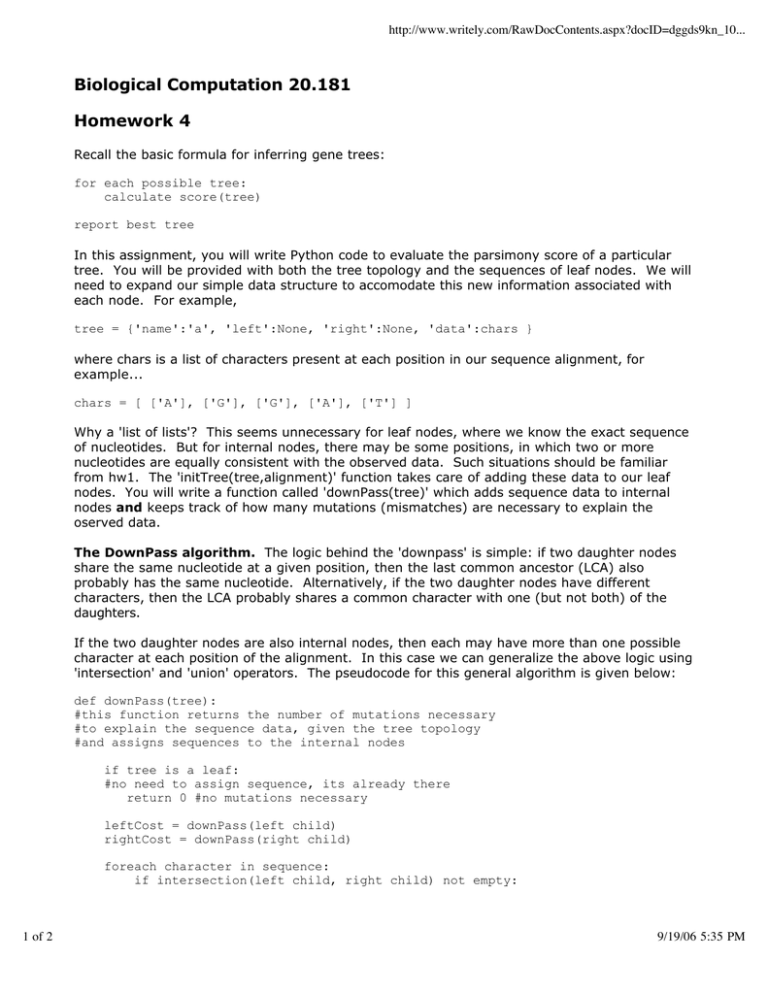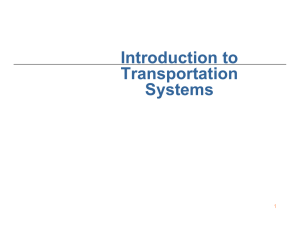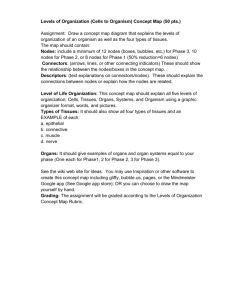Biological Computation 20.181 Homework 4
advertisement

http://www.writely.com/RawDocContents.aspx?docID=dggds9kn_10...
Biological Computation 20.181
Homework 4
Recall the basic formula for inferring gene trees:
for each possible tree:
calculate score(tree)
report best tree
In this assignment, you will write Python code to evaluate the parsimony score of a particular
tree. You will be provided with both the tree topology and the sequences of leaf nodes. We will
need to expand our simple data structure to accomodate this new information associated with
each node. For example,
tree = {'name':'a', 'left':None, 'right':None, 'data':chars }
where chars is a list of characters present at each position in our sequence alignment, for
example...
chars = [ ['A'], ['G'], ['G'], ['A'], ['T'] ]
Why a 'list of lists'? This seems unnecessary for leaf nodes, where we know the exact sequence
of nucleotides. But for internal nodes, there may be some positions, in which two or more
nucleotides are equally consistent with the observed data. Such situations should be familiar
from hw1. The 'initTree(tree,alignment)' function takes care of adding these data to our leaf
nodes. You will write a function called 'downPass(tree)' which adds sequence data to internal
nodes and keeps track of how many mutations (mismatches) are necessary to explain the
oserved data.
The DownPass algorithm. The logic behind the 'downpass' is simple: if two daughter nodes
share the same nucleotide at a given position, then the last common ancestor (LCA) also
probably has the same nucleotide. Alternatively, if the two daughter nodes have different
characters, then the LCA probably shares a common character with one (but not both) of the
daughters.
If the two daughter nodes are also internal nodes, then each may have more than one possible
character at each position of the alignment. In this case we can generalize the above logic using
'intersection' and 'union' operators. The pseudocode for this general algorithm is given below:
def downPass(tree):
#this function returns the number of mutations necessary
#to explain the sequence data, given the tree topology
#and assigns sequences to the internal nodes
if tree is a leaf:
#no need to assign sequence, its already there
return 0 #no mutations necessary
leftCost = downPass(left child)
rightCost = downPass(right child)
foreach character in sequence:
if intersection(left child, right child) not empty:
1 of 2
9/19/06 5:35 PM
http://www.writely.com/RawDocContents.aspx?docID=dggds9kn_10...
tree['data'] += intersection(left child, right child)
else:
tree['data'] = union(left child, right child)
mutations += 1 #left and right trees disagree, so there must be at
least one mutation
return mutations + leftCost + rightCost
Implement the downPass algorithm in the codebase provided.
The downPass algorithm successfully accounts for the minimum number of mutations necessary
to explain a sequence alignment given a topology, yet the sequences at the internal nodes are
not necessarily the best under the parsimony criterion. Why is this? (hint: the root node is
optimal under parsimony -- what is different about the root and other internal nodes?)
2 of 2
9/19/06 5:35 PM




